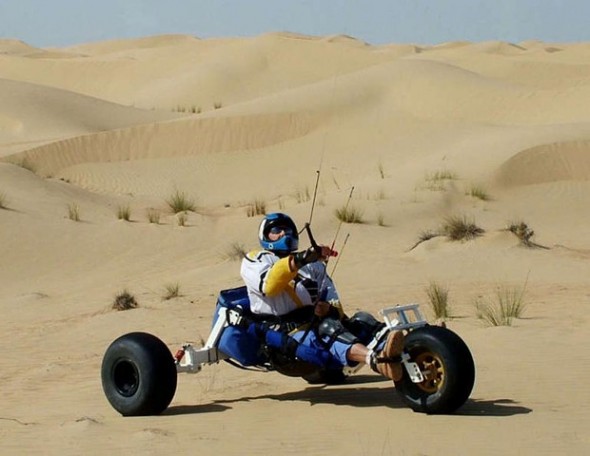How do you Ride the Desert Dunes?
Here Sand Yeti explains just how its done
1) Consideration must be given to sand conditions. Usually after an infrequent heavy rain (2 to 3 times a year if we are lucky), the dunes are hard packed & the leeward & windward side of dunes are very easy to run up. Often the leeward sides are very soft & won’t even bother trying to get up them because the buggy will just get bogged down. In such cases, I will run along the trough between dunes until I see a place where I can get through.
2) Going upwind in dunes is something I avoid at all costs simply because one can spend say 20 minutes trying in difficult dune areas & make almost no forward progress.
3) The prevailing winds typically cause the dune formation in longs strings, so running up windward sides of dunes is easy because the wind is pulling me up the steep slope.
4) Another way to climb big dunes is to be on the crest of one dune, accelerate down the steep dune to obtain sufficient momentum to get up the next dune. We have a run that we have named the Half Pipe because it is similar to a snowboarder barrelling up & down a preformed Half Pipe in the snow.
5) In the early days of dune buggying, I had lots of difficulty to judge sand conditions, size of slope, which meant I would either fail to get up to the dune ridge or would be going so fast that I would continue going up on reaching the ridge , while my buggy was descending the downward slope. This called for some parachuting landing technique that I became quite good at having been going to quickly at dune ridges on many occasions.
6) One of the important things about running dunes is, ‘Speed Control’. If for example I approach a ridge too fast, I will quickly collapse the kite to reduce the pull on me to avoid being lifted out of the buggy as mentioned in point 5. The kite collapsing trick is only partial & once the speed is correct I take the brakes off & let the kite do its job.
7) Descent of dunes is something I don’t think much about these days but earlier I would ride under the kite & the kite would collapse. The trick on the descent is to ensure that the kite lines are always kept taught. Failure to manage that will have the kite fluttering down behind a dune.
8) Additionally, to the above because one doesn’t know what lies behind a dune, one needs to be ready for whatever is there to take evasive action. It could be a sleeping camel, a dead tree laying on its side, heaped sand mounds cause by camel grass growing in that area. Then there are holes & other weird undulations that are good to avoid.
9) One of the tricks that I use is when riding along a ridge might be of interest. As the ridges are usually knife edged, I keep the downwind rear buggy wheel riding exactly on the ridge. If the ridge starts to descend, the buggy will speed up & there is a concern that the lines will go slack. In those cases, I move the rear wheel toward the kite side so I am effectively saddling the ridge. This causes the rear axle to dig into the ridge & effectively become a brake. With buggy going slower, the wind pulls the kite & lines tighten.
One can discuss the fundamentals of dune riding but to be realistic, it takes a lot of practice because there is a lot to think about and you have to be making decisions what to do, where to go & how to manage every few seconds.

